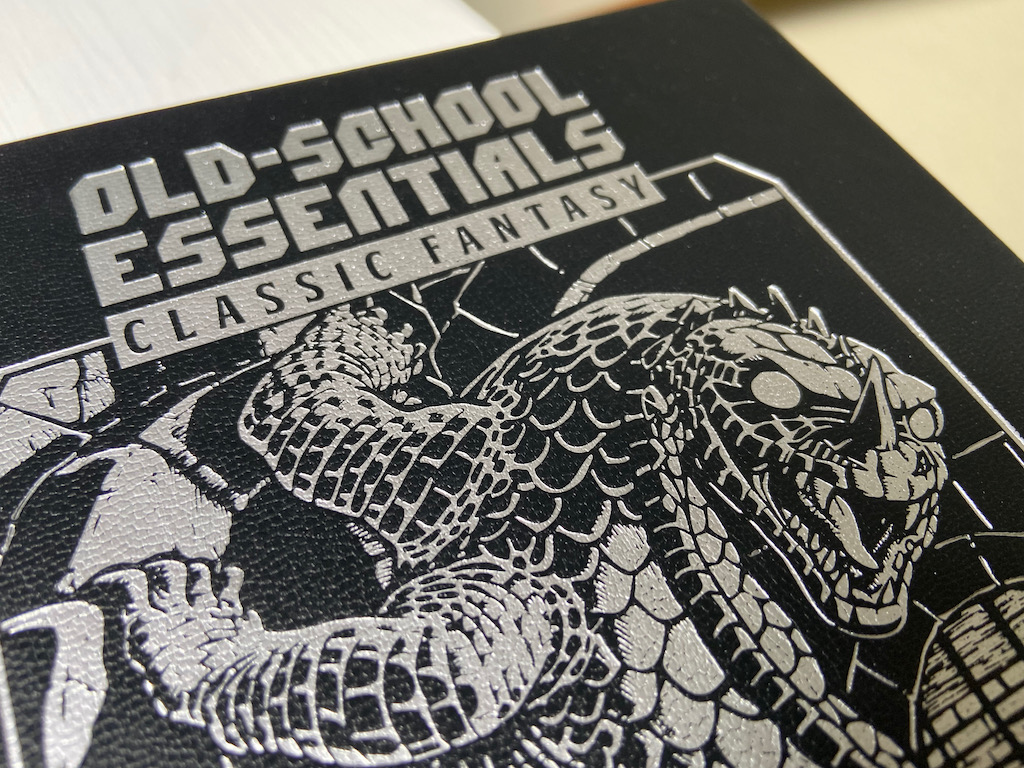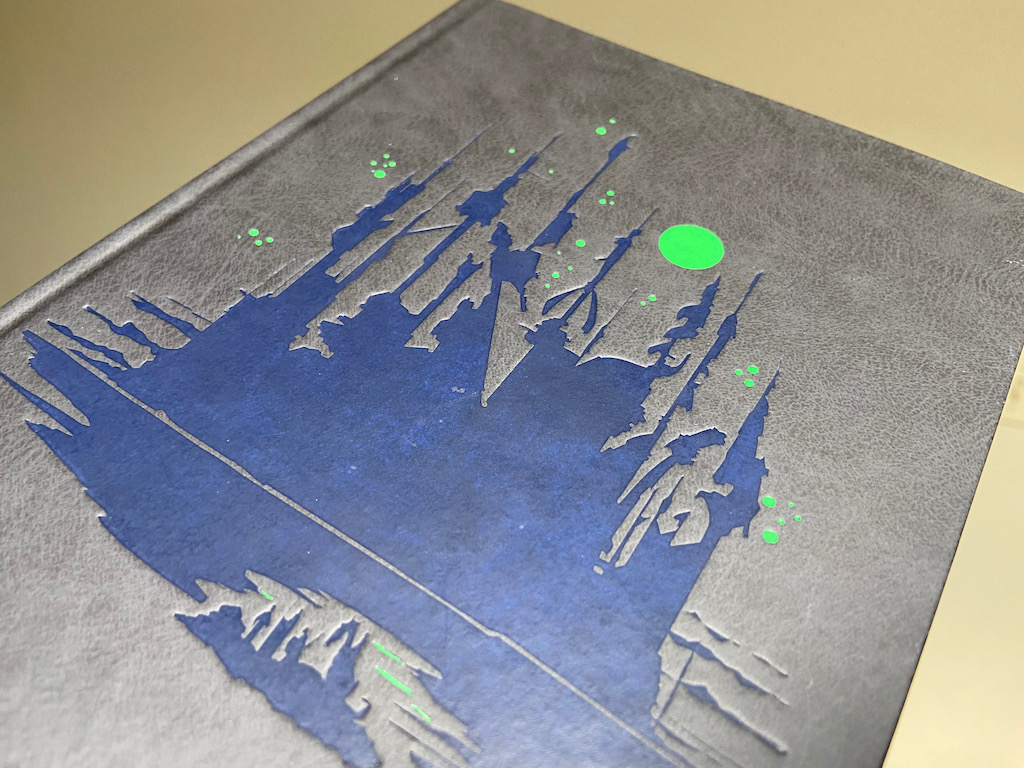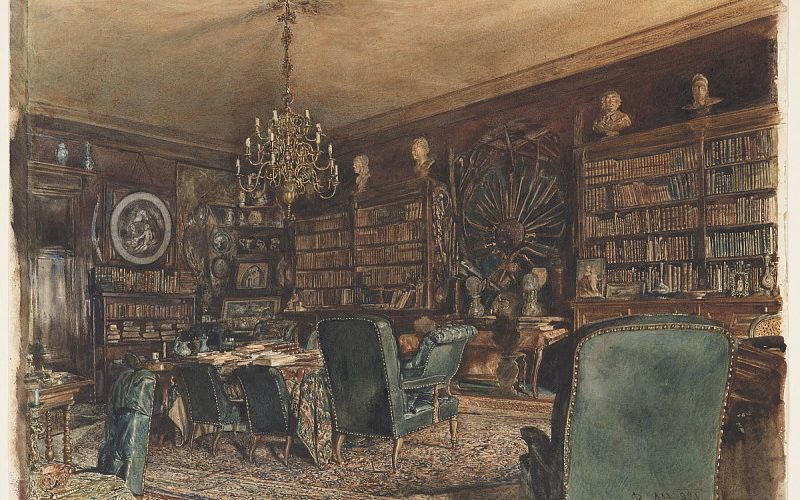Several years ago, as I was contemplating the overburdened bookshelf next to my desk at our old one-bedroom apartment, I made a decision: no more physical RPG books if I can help it, and if I make any exceptions, then core books only. No splatbooks! No adventures! PDFs were the way of the future, and while I wasn’t interested in adopting an all-digital lifestyle when it came to gaming, having a physical core rule book on the table and supplemental expansion material in PDF seemed like a good compromise for a less-cluttered bookshelf.
That minimalist resolution endured for about a week. Well, maybe not literally a week, but it didn’t take long for books to start trickling onto the shelves again. I think it was Red and Pleasant Land that started it; it was just such a gorgeous physical book, who could blame me for acquiring a physical copy to put on the shelf? And why not add Vornheim as a companion? Then, of course, a physical copy of LotFP’s Rules and Magic should go with that— it’s such a slim, tidy book; it barely takes up any space at all!
Now, some years and a move later, I’m once again contemplating some even more overburdened bookshelves. My prior vow still stands… sort of. I try not to acquire a physical anything unless I actually have a genuine interest in playing it (or, perhaps more accurately, running it). I know that sounds like a silly distinction, but it’s why I don’t have a physical copy of any version of Shadowrun— I’d happily play it if someone were organizing a game, but it’s not on my short-list of games I’d run, if that makes any sense. I’ve also mostly avoided splatbooks, but there’s some fuzzy areas. Is the Monster Codex an extraneous supplement to the Symbaroum core book, or an essential volume? Similarly I’ve mostly avoided adventures, although the glaring exceptions there are the myriad LotFP titles.
But, all this is to say that, as a person with no active game at present, I’m perhaps in danger of becoming an RPG collector instead of an RPG player. And although collecting is a perfectly valid way of engaging with the hobby, my ideal self appreciates things for their use & enjoyment, not just their acquisition. RPGs come to life when played, and while I enjoy reading them as imagination springboards, they, like Shakespeare, seem to be something that should activated by a group of people in order to experience them in their intended state. A chessboard can be a fine decoration for a fancy parlor, but really the best thing about chess is playing it.
(As an aside, I have not yet made good on my ‘get a game going’ goal from my last post. There have been a lot of assignments due, and I’ve been distracted by schoolwork! But, with finals and summer approaching, I anticipate some recreational time soon.)
The burdened bookshelf has been on my mind lately in part due to a recent Instagram post/YouTube video by Hankerin Ferinale of Runehammer fame, who has recently, it seems, culled his physical bookshelf down to a mere five volumes. He discusses his rationale at the video link above, and I won’t restate all that here, but I can understand the feeling of “lightness” that comes from paring down to the essentials. Several years ago, my wife and I packed up all our belongings and put all of it into storage shortly after we got married and hit the road for a year-long semi-nomadic existence. During that time, my hobbies were essentially what could fit into my camera bag. The constraint of simplicity was nice. So, Hankerin’s post got me thinking: what would I pare down to if I were to do that again? That is, what five physical books would I find inspiring enough to keep at hand, with the rest living a digital existence on the hard drive? I don’t have any actual intention to get rid of books right now, but here’s my five “keeper” books, in no particular order, and just reflecting my current “gaming mood.”
Old School Essentials Rules Tome
Yes, this is the cliché New Hotness, and yes, it parallels one of the Hankerin selections mentioned above, but I like it. It was actually a hard decision between this or LotFP’s Rules & Magic, but ultimately this one won out by a narrow margin as a nice, tidy compendium of B/X D&D. Another contender would be the original Basic & Expert books I snagged at the game store a couple years ago, but that technically would’ve been two books, right? The OSE version gives me a nice two-for-one, and a snazzy leatherette cover with a couple ribbon bookmarks to boot.

The inspirational appeal of this one is its fundamentally complete nature: it’s everything you need, but it also invites creativity and house-ruling. It’s extensive, but not overboard. I flip through it, and I just want to run an old fashioned wilderness adventure/dungeon crawl! It’s even encouraged me to start prepping one for some future campaign: I’ve got a nascent “vanilla” setting I’ve been working on, where I’ve been populating the old Outdoor Survival hex map with some dungeons and points of interest utilizing B/X as it’s conceptual “assumed” ruleset.
Forbidden Lands
This is another Hankerin parallel for me too. One would think it’s redundant compared to OSE, but there is room in my heart for two fantasy settings! Where OSE inspires me in part because of its tried & true forty year-old rules, Forbidden Lands inspires me with its “new rules but old sensibilities” approach. I enjoy the Year Zero system of throwing handfuls of dice and the mechanical parts of this game for things like overland adventure and critical injuries. Where I find the blank slate of B/X inspiring, I find the developed setting of Forbidden Lands compelling too. I want to explore this place, and find out what weird things are going on!

Forbidden Lands makes me want to fill in the setting in more detail, and it’s a fun diversion for me to use the site generators in the Gamemaster’s Guide to try to cook up some locales to prep for a “someday” campaign.
Carcosa
Carcosa! I’ve talked about this one before. Like Forbidden Lands, I just want to find out more about this place every time I flip through the book. One of the fun (or to some views frustrating) aspects of the book is that it requires a little bit of creativity on the part of the GM to really fill it out. Sure, hex number whatever features a citadel of seventeen orange men led by a neutral 5th level fighter called “The Ascendancy of the Repatriated Vision,” but what exactly does that mean? Are they bandits? Do they ride dinosaurs? What are their opinions about the tree-formed Spawn of Shub-Niggurath in the hex next door? The by-the-book descriptions hint at a world of petty fiefdoms struggling for survival and squabbling over sci-fi technology, and it really makes me want to fill out develop some adventure sites in each hex in the same manner of the included “Fungoid Gardens of the Bone Sorcerer” that brings Hex 2005 to life.

Red & Pleasant Land
Like the other books on my list, this one is just such a nice physical book to hold, as well as full of great, inspirational content. I’m not sure I’ll ever properly run a game in Voivodja, but everything about the book makes me want to explore it. It also makes me want to step up the level of my own creations, and add an extra layer of unique “weirdness” to things. Not weird for the sake of weird, that is, but a slightly more “thought out” weird; the kind of weird that makes elves or dwarves strange and alien, not just stock tropes like “Forest Vulcans” and “Viking Miners.” This kind of weirdness (though more restrained) shows up a bit in Forbidden Lands too.

But for me, the inspiration of Red & Pleasant Land, and indeed all of Zak’s work, is a sense of “drawing outside the lines.” Don’t worry about counting squares, or how wide the room is. Maybe the chamber is 20 feet or 30 feet wide? At the game table it doesn’t really matter; players will remember the strange frieze described on the wall, or the odd orrery with the planets represented by glass globes filled with different colors of beetles. Focus on the things that make the game cool, fun, and memorable, in other words, instead of making sure your fantasy city has a historically accurate number of glove makers and coopers to properly simulate a “realistic” pseudo-medieval environment.
Conclusion
And that, I suppose, is the five RPG books I’d grab off the shelf if I had to immediately trim the collection right now. I wonder if my choices will be different in six months, or a year? It’s an interesting thought experiment to imagine clearing off the bookshelves that dramatically. I confess I envy the simplicity of cutting back to “just five books,” but it’s also something I’m unlikely to do, and to be honest I derive a lot of satisfaction from the books right now. They “spark joy,” to use the parlance of that lady who organizes homes. I’ve got another motivation too: I want them on the shelves for my kids to discover. I think a shelf full of strange books is an important thing for kids to find as they get older, and although I recognize it may be folly to hope that my kids will have the same interests as me in eight to ten years, I’m willing to keep the shelves stocked until I find out one way or another.
In the meantime, maybe I’ll ignore studying for my finals for a little bit and indulge myself by figuring out what kinds of Monsters & Treasure might be found in the Volcano Dungeon for that notional “B/X Outdoor Survival” campaign I’ve been fiddling with…
